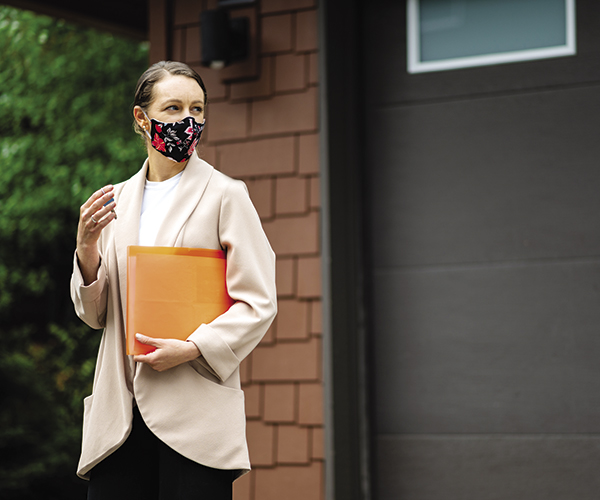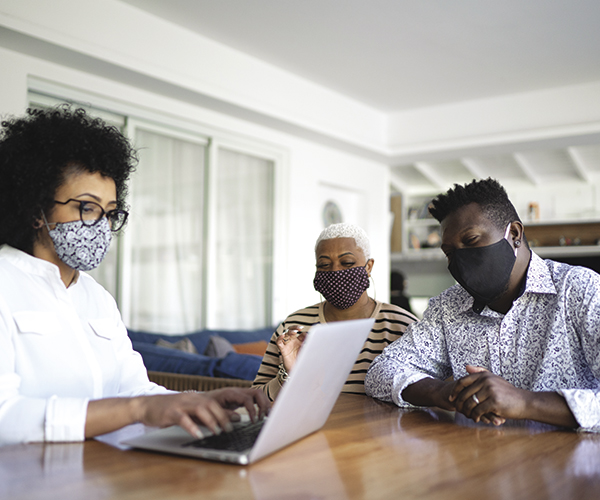Ian and Nicole Memmer started looking for their first home in December, keeping their search fairly casual. They scrolled through online listings, hit a few open houses and figured they’d wait until early March to get serious. “That was exactly when the coronavirus hit,” says 29-year-old Ian Memmer.
With the lease on their Westlake apartment set to expire in May, the hunt for a new home suddenly became a whole different game. Rather than attending low-pressure open houses, they first relied on virtual tours. “We had to know exactly which houses we wanted to go to,” says 25-year-old Nicole.
They eventually toured occupied homes on the market while taking precautions. “You have no idea who is currently living in the house,” Ian says. “Who knows if one of us could have been exposed, too.”
The couple physically toured about a dozen homes before deciding on a Bay Village house; they had to go into so many because homes were selling so quickly. “By the time you went to make an offer, someone else had already put in a bid,” Ian says.
Despite the uncertainty and anxiety caused by a pandemic, real estate agents are reporting that buyer interest hasn’t waned. “Multiple offers are still coming in on homes,” says Katie Manos, an agent with Howard Hanna in Bay Village. She says homebuyers are practicing “respectful social distance” while taking advantage of online tools including FaceTime and 3D online tours.
In-person viewings are handled with care — and with supplies such as gloves, shoe covers, Purell, masks and disinfectant wipes. Also, there are contract addendums that give buyers and sellers a cushion for delays.
“The number of people who are putting their search on hold is not as many as you would think,” says Mike Ferrante, an associate broker at Century 21 Homestar: 21 Mike Team based in Solon. Buyers are competing for listings and prices are steady, even increasing, in spite of the coronavirus. “People are afraid they might miss out on the perfect home.”
Supply and Demand
While buyers across Northeast Ohio are scooping up houses pretty quickly, potential sellers are considering their options. Ones who don’t have to sell are waiting, while others have had their financial situations change. So though housing supply is low, the demand is up for what inventory comes online. “Demand has increased because some [sellers] have taken themselves out of the game, or they were removed from the game because they lost a job, were furloughed,” Ferrante says.
Not having a strong portfolio of homes to choose from also changes the expectations for potential buyers.
“I knew that buying a house was going to be stressful and we’d have to act quickly, but I didn’t think it would be this quick and this stressful,” Ian says.
The normal pressures of finding the perfect house and competing with other buyers are now amplified by worries about an uncertain market and low inventory.
“During the time we were looking, we were scared about what was going to happen to the market in the next one to 12 months,” Nicole says. “Is it going to crash? Are house prices going to go down, go up or stay the same? We tried to make the best decision as we could based on what was going on that second.”
And for the Memmers, it felt like the houses they wanted were selling in a second, which led them to lower their expectations and consider homes that weren’t turnkey, might have needed some work or were smaller than what they first envisioned.
“Some of the houses we considered because there were no other options,” Ian notes. “Under ideal conditions, we might not have looked at them, but there were so few houses to select from.”
Virtual, Then Reality
Serious buyers are taking advantage of “no-touch showings.”
Vincent Incorvia with Re/Max Real Estate Group has watched the industry’s technology evolve during his 26-year career. Video isn’t brand-new. Neither are virtual showings, particularly for out-of-town buyers or investors.
“Coronavirus might have rushed the technology a little — but not really,” he says. “We were already using many of these tools.”
Specifically, Incorvia is speaking of virtual tours where he walks through homes while on a FaceTime or Zoom call with buyers. “It’s real-time and the value is, I can say, ‘There is a dated fixture you’ll want to replace,’ or, ‘It looks like there is discoloration in the ceiling here, so there might have been a leak in the past. You’ll want a home inspector to look into that.’ ”
With a live video tour, he can zoom in to show what countertops look like and help buyers understand how a home’s floor plan flows.
There are also virtual tours that essentially sew together professional photographs of a home into a slideshow presentation. Video tour software like Matterport allows realtors to film footage so buyers can watch a tour and zoom in on features.
“Agents have to get creative,” Ferrante says, noting that open houses are now a virtual event. “I spent an hour at a house on Facebook Live and then Instagram Live, and I basically walked around the home and talked about its features. If anyone had questions, I would answer them and show them areas of the house they asked to see.”
Still, nothing quite replaces the experience of visiting a home in person.
“For most people, a house is typically their largest purchase and they want to see it,” Incorvia says.
“With the house we ended up putting an offer on, the sellers were still living in it,” says Meridith Manson, who was searching for a home in Lakewood to blend families with her partner, Brent Ferguson. “This was a house we were thinking we’d spend the rest of our lives in, yet we were hesitant to touch any surface.”
Manson and Ferguson used online tools to narrow their search. They were disappointed that they could not bring their children along to tour in person. But since the couple were also selling their homes, they understood. “People are taking the precautions seriously, but it’s ultimately up to the agent to remind them,” Ferrante says.
Ferguson describes the protocol his realtor took when listing his Wickliffe home. “The realtor said they would do only one showing at a time, 15 minutes apart, and no kids were allowed to come to the showings,” he says.
Manson and Ferguson assembled “welcome kits” for the entryway that included gloves, hand sanitizer and a friendly reminder to remove shoes. Manson sold her Bay Village home in one day, and Ferguson was surprised that his Wickliffe house was on the market for only one day, too. “I thought mine might take longer,” he says.
COVID-19 Contracts
Adding to buyer-seller confidence are the coronavirus contract addendums that build wiggle room into closing dates. Real estate contracts include time allowances for submitting financing applications and mortgage approval by a lender, which first involves an appraisal and underwriting process. A closing and transfer date is named with “on or about” terminology. If the buyer does not complete the necessary processes by the contract’s timelines, the seller can ask to be released from the contract.
Because of administrative delays as lenders, appraisers, title companies and realtors work through the coronavirus, many realtors are including COVID-19 contract clauses that give buyers and sellers some leeway on the closing and transfer dates, generally 10 to 30 days. “We are trying to avoid a deal getting delayed by a day or two and one party or the other saying, ‘We didn’t close on time, the deal is off,’ ” Ferrante says.
Real estate contracts with “on or about” language already give buyers and sellers this leeway, but a COVID-19 addendum tends to give both parties more peace of mind, Incorvia says. “There are guidelines in a contract you can extend if you need additional time, so a COVID-19 addendum adds another document on top of that as a comfort factor,” he says.




